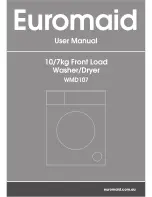
Instruction manual DI652
42
Please keep this instruction manual for future reference
T R O U B L E S H O OT I N G T I P S
B E F O R E C A L L I N G F O R S E RV I C E
Reviewing the charts on the following pages may save you from calling for service.
P R O B L E M
P O S S I B L E C AU S E S
W H AT TO D O
Dishwasher doesn’t start
Fuse blown, or the circuit
break tripped.
Replace fuse or reset circuit breaker. Remove any other
appliances sharing the same circuit with the dishwasher.
Power supply is not turned on.
Make sure the dishwasher is turned on and the door is
closed securely. Make sure the power cord is properly
plugged into the wall socket.
Water pressure is low.
Check that the water supply is connected properly and the
water is turned on.
Door of dishwasher not
properly closed.
Make sure to close the door properly and latch it.
Water not pumped
form dishwasher
Twisted or trapped drain hose. Check the drain hose.
Filter clogged.
Check the filter.
Kitchen sink clogged.
Check the kitchen sink to make sure it is draining well. If
the problem is the kitchen sink that is not draining, you may
need a plumber rather than a serviceman for dishwashers.
Suds in the tub
Wrong detergent.
Use only the special dishwasher detergent to avoid suds.
If this occurs, open the dishwasher and let suds evaporate.
Add 1 gallon of cold water to the bottom of the dishwasher.
Close the dishwasher door, then select any cycle. Initially,
the dishwasher will drain out the water. Open the door
after draining stage is complete and check if the suds have
disappeared. Repeat if necessary.
Spilled rinse-aid.
Always wipe up rinse-aid spills immediately.
Stained tub interior
Detergent with colourant may
have been used.
Make sure that the detergent has no colourant.
White film on inside
surface
Hard water minerals.
To clean the interior, use a damp sponge with dishwasher
detergent and wear rubber gloves. Never use any other
cleaner than dishwasher detergent otherwise, it may cause
foaming or suds.







































